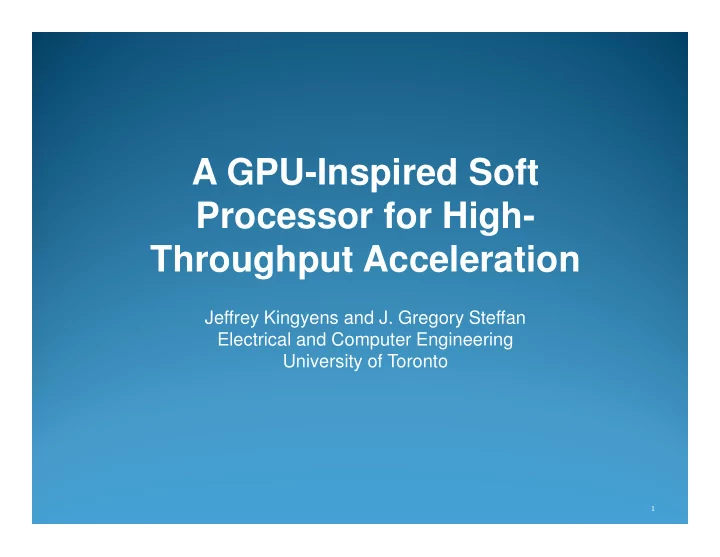

A GPU-Inspired Soft Processor for High- Throughput Acceleration Throughput Acceleration Jeffrey Kingyens and J. Gregory Steffan Electrical and Computer Engineering University of Toronto 1
FGPA-Based Acceleration � In-socket acceleration platforms � FPGA and CPU on same motherboard � Xtremedata, Nallatech, SGI RASC � How to program them? � How to program them? � HDL is for experts � Behavioural synthesis is limited XD1000 Can we provide a more familiar programming model? A GPU-Inspired Soft Processor 2
Potential Solution: Soft Processor � Advantages of soft processors: � Familiar, portable, customizable � Our Goal: Develop a new S.P. architecture that: � Excels at high-throughput workloads � Is naturally capable of high utilization of datapath � Challenges: � Memory latency � Pipeline latency and hazards � Exploiting parallelism � Scaling A GPU-Inspired Soft Processor 3
Inspiration: GPU Architecture � Multithreading � Tolerate memory and pipeline latencies � Vector instructions � Data-level parallelism, scaling � � Multiple processors � Scaling Long-term goal: FPGA-specific design using above This work: FPGA implementation of a GPU A GPU-Inspired Soft Processor 4
Overview � A GPU-based system � NVIDIA’s Cg � AMD’s CTM r5xx ISA � A GPU-inspired architecture � Overcoming port limitations � Avoiding stalls � Preliminary results � Simulation based on Xtremedata XD1000 A GPU-Inspired Soft Processor 5
A GPU-Based System A GPU-Based System A GPU-Inspired Soft Processor 6
GPU Shader Processors ( X o ,Y o ) Register Fetch ( n, x , y ) File Shader Program Constant Data Registers Registers Input Buffers Y o X o Output Buffer Separate in/out buffers simplify memory coherence A GPU-Inspired Soft Processor 7
NVIDIA’s Cg Language ( C -like) Cg Shader struct data_out { Program float4 sum : COLOR ; }; data_out multadd( float2 coord : TEXCOORD0 , uniform sampler2D A: TEXUNIT0 , uniform sampler2D A: TEXUNIT0 , uniform sampler2D B: TEXUNIT1 ) { data_out r; float4 offset = {1.0f, 1.0f, 1.0f, 1.0f}; r.sum = tex2D (A,coord)* tex2D (B,coord)+offset; return r; } Matrix-matrix element-wise multiplication + offset 8 A GPU-Inspired Soft Processor
AMD’s CTM r5xx ISA (simplified) multadd: TEX r1, r0 s1 Loads TEX r0, r0 s0 ALU op ALU op MAD o0, r1 r0 c0 MAD o0, r1 r0 c0 A B C END Dest regs Source regs Each register is a 4-element vector 9 A GPU-Inspired Soft Processor
A GPU-Inspired Architecture A GPU-Inspired Architecture A GPU-Inspired Soft Processor 10
Soft Processor Architecture Soft Processor HT Config Coordinate Generator Slave FPGA Block- RAMs Register File have only 2 ports! A A B C TEX 64 ALU Cycles! 305 cycles! HT Fifo Master Fifo Output Register Must tolerate port limitations and latencies A GPU-Inspired Soft Processor 11
Overcoming Port Limitations � Problem: central register file: � Needs four reads and two writes per cycle � FPGA block RAMs have only two ports � Solution: exploit symmetry of threads � Symmetry: every thread executes same inst sequence � Group threads into batches of four � Fetch operands across batches in lock-step Only read one operand per thread per cycle A GPU-Inspired Soft Processor 12
Reading Operands Across Batch Batch (of 4 threads) multadd: multadd: multadd: multadd: TEX r1 r0 s1 TEX r1 r0 s1 TEX r1 r0 s1 TEX r1 r0 s1 TEX r0 r0 s0 TEX r0 r0 s0 TEX r0 r0 s0 TEX r0 r0 s0 MAD o0 r1 r0 c0 MAD o0 r1 r0 c0 MAD o0 r1 r0 c0 MAD o0 r1 r0 c0 END END END END Three cycles to read operands: 1) Read A’s 2) Read B’s 3) Read C’s Only read one operand per thread per cycle A GPU-Inspired Soft Processor
Transposed RegFile Access T3 T2 T1 T0 RF RF RF RF 3 2 1 0 3 2 1 0 3 2 1 0 C B A A GPU-Inspired Soft Processor 14
Avoiding ALU Pipeline Bubbles � Problem: long pipeline and memory latency Frequent stalls lead to underutilized ALU datapath � � Solution: exploit abundance of threads Store contexts for multiple batches of threads Store contexts for multiple batches of threads � � � Issue instructions from different batches to hide latencies Requires logic to issue-from and manage batches How many batches do we need to avoid bubbles? A GPU-Inspired Soft Processor 15
Issuing from Multiple Batches Batch: 0 1 2 3 ALU Pipeline Ideally ALU is fully utilized A GPU-Inspired Soft Processor
Methodology and Results Methodology and Results A GPU-Inspired Soft Processor 17
Simulation Methodology � SystemC-based simulation � Parameterized to model XD1000 � Assume conservative 100Mhz soft processor clock � Cycle accurate at the block interfaces � Cycle accurate at the block interfaces � Models HyperTransport (bandwidth and latency) � currently 8-bit HT, capable of 16-bit HT � Benchmarks � photon: monte-carlo heat-transfer sim (ALU-intensive) � matmatmult: dense matrix multiplication (mem-intensive) A GPU-Inspired Soft Processor 18
ALU Utilization (8-bit HT) 100% tilization (%) 80% Data Hazard 60% Memory ALU Utiliz Not ALU Not ALU 40% Utilized 20% 0% 1 2 4 8 16 32 64 Number of Hardware Batch Contexts (Photon) A GPU-Inspired Soft Processor 19
ALU Utilization (8-bit HT) Utilized Not ALU Memory Data Hazard Matmatmult is bottlenecked on memory bandwidth A GPU-Inspired Soft Processor 20
ALU Utilization (16-bit HT) Utilized Not ALU Memory Data Hazard 32 batches is sufficient A GPU-Inspired Soft Processor 21 21
Conclusions � GPU-inspired soft processor architecture � exploits multithreading, vector operations � Thread symmetry and batching allows: � tolerating limited block RAM ports � tolerating long memory and pipeline latencies � tolerating long memory and pipeline latencies � 32 batches sufficient � to achieve 100% ALU utilization � Future work: � customize programming model and arch. to FPGAs � exploit longer vectors, multiple CPUs, custom ops A GPU-Inspired Soft Processor 22
Recommend
More recommend